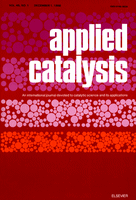"Solid-State Nuclear Magnetic Resonance Studies of the Transformation of the Zeolite Y Catalyst in the Course of Hydrochlorination of 1-Methylcyclohexene by Thionyl Chloride"
Waclaw Kolodziejski, Lionel Delaude, Pierre Laszlo, Marie-Thérèse Montaufier, and Jacek Klinowski
 |
source: Applied Catalysis
year: 1993
volume: 98
first page: 71
last page: 79
doi: 10.1016/0926-860X(93)85026-L
|
Abstract: 1-Methylcyclohexene was hydrochlorinated with SOCl2 to 1-chloro-1-methylcyclohexane at room temperature in CH2Cl2 as the solvent and in the presence of the faujasitic zeolite ZF520 catalyst. 4-Coordinated framework aluminium in the parent sample coexisting with a small amount of immobile extraframework aluminium at ca. -1 ppm is completely removed after just one reaction run and transformed into two distinct 6-coordinated species resonating at 0.2 and -3.1 ppm. The former line is assigned to Al(H2O)6 3+ cations, the latter is likely to come from a species with mixed solvation shells, probably Al(Cl-)(H2O)5 2+. Crystallinity of the catalyst is seriously affected by the reaction. The spectra confirm that before reaction the zeolite contains Si(3Si,1OH) and Si(2Si,2OH) groups. During the reaction most hydroxyl groups created by dealumination are removed, although some Si(3Si,1OH) remain. MAS NMR spectra are fully consistent with the proposed reaction mechanism.
Keywords: Catalyst Characterization (NMR, XRD), Methylcyclohexene Hydrochlorination, Nuclear Magnetic Resonance, Reaction Mechanism, Thionyl Chloride, Zeolite Y, Zeolites
[Full Text] [<< Previous Article] [Back to the List of Publications] [Next Article >>] l.delaude@ulg.ac.be